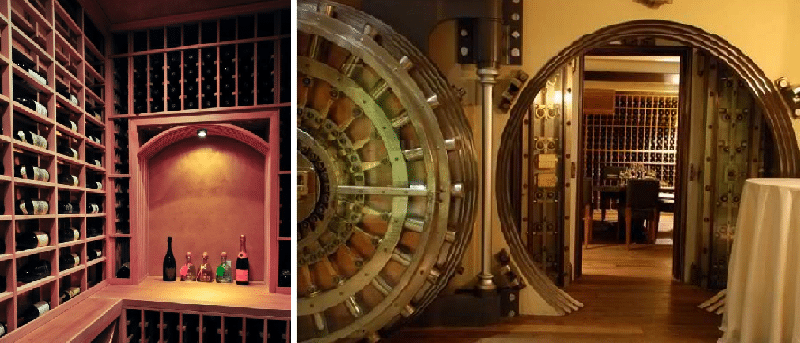How Heat and Oxidation Affect Wine
Contents
Wine is a beverage that requires certain conditions to be met in order for it to be stored safely. It is a very sensitive drink, and if improperly stored, It can lose its quality and acquire an unpleasant taste. Two of the most dreadful enemies of wine are heat and oxidation. Learn all about how heat and oxidation affect wine by reading through this article.
1. Oxidation
a. Oxidation is Part of Wine Aging
Oxidation is actually a natural part of wine aging. Oxidation is the chemical process that occurs when the chemical compounds in wine come in contact with oxygen. In order for wine to age, it needs to be exposed to a small amount of oxygen. Oxidation happens in every wine bottle. The empty or unfilled part of every wine bottle, called the ullage, contains a very small amount of oxygen, which is adequate for an acceptable level of oxidation to happen.
b. When is Wine Too Oxidized?
When wine is completely oxidized, it is a dead wine. Its flavor is either rusty or flat, and its quality is totally damaged. When wine is exposed to oxygen, some of the volatile chemicals that are responsible for its aroma are also taken out. Repeated exposure to oxygen will also cause the color of wine to change. Red wine will begin to take on a brick-red to brown color, while white wine will start to darken and take on an amber to golden brown hue.
It is important to note that white wines are commonly more susceptible to oxidation compared to red wines. This is because red wines contain more tannins. Tannins act as antioxidants, which help protect wine from oxidation. But whether you have white or red wines, you should make sure that your entire wine collection is protected from oxidation.
2. The Correlation Between Oxidation and Heat
Heat and oxidation are strongly related to each other. Heat increases the rate at which wine oxidizes. This means that heat causes wine to age faster than is ideal. For every 18 degrees Fahrenheit in temperature, the rate at which wine ages doubles. Therefore, when you store wine at a room temperature of 73 degrees Fahrenheit, the aging potential of wine is cut in half compared to when it is stored at the ideal temperature of 55 degrees Fahrenheit.
This does not seem to be a bad thing for some people, because they misunderstand the concept of wine aging. For example, since a Cabernet Sauvignon is supposed to age for 10 years before it is enjoyed, some try to cut its wine storage time in half, by storing the beverage at room temperature. What they fail to understand is that wines need to age gradually and not hastily. If the wine is allowed to age too quickly, it will end up tasting bad. Wines stored in temperatures above 80 degrees Fahrenheit are in danger of being cooked. Cooked wine will smell like burnt sugar or stewed fruit. Slightly cooked wines have dull flavors and aromas.
Moreover, very high temperature can cause the wine bottle corks to protrude and, thereby break the cork seal. This will lead to the overexposure of wine to oxygen.
If wine is damaged by heat, you can either throw it away or consume it within 24 hours. That, is if it is still palatable. The longer you wait, the worse the damage will be. Even if you try to salvage the wine being putting it in a custom wine cellar, the wine damage has begun and will continue to worsen.
Common Causes of Oxidation and Heat Exposure
Heat exposure and oxidation can irreversibly damage your wines. Here are the most common causes of these:
1. Temperature Fluctuations
The most common and most damaging cause of wine oxidation is through consistently fluctuating temperature levels. Wine should be kept in the ideal wine storage temperature, with minimal to no fluctuations. Damaging fluctuations refer to those in excess of 1 to 3 degrees Fahrenheit daily.
When wine heats up, it expands, and the pressure on the cork increases. When the wine cools down, it contracts, and creates a pressure differential that pulls air into the wine bottle. The more frequent the fluctuations in temperature, the more air that gets into the bottle and causes oxidation.
To avoid temperature fluctuations, make sure that your residential custom wine cellar is properly designed and built, with a sturdy wine cellar door and an efficient wine cellar cooling unit.
2. Exposure to Ultraviolet Light
Wine should be protected from exposure to ultraviolet light. “Lightstruck” or “Gouts de Lumiere” (a French phrase, meaning “tastes of light”) are terms used to refer to wines that have been exposed to excessive sunlight or fluorescent light. Wines that are overexposed to ultraviolet light have a wet cardboard or wet wool flavor and aroma.
This is why most wines come in dark-colored bottles: so that they are protected from ultraviolet light. Your home custom wine cellar in Los Angeles, California should keep wines away from sunlight, and should not have lighting fixtures that produce harmful light. The safest lightings to use inside a wine cellar are LED lights, because they produce minimal heat and do not emit ultraviolet light.
Ideal Conditions for Wine Storage
To protect your investment, make sure that you have the right storage solution for your wine collection. Wines need to be kept in a place wherein the temperature is approximately 55 degrees Fahrenheit, and the humidity is around 70%. Moreover, the wine storage room should be dark, with no vibrations.
The most ideal place to keep wines is in a custom wine cellar. A properly planned and constructed custom wine cellar with an efficient wine cellar refrigeration unit can provide the ideal conditions for wine to age tastefully.
Coastal Custom Wine Cellars is one of the best wine cellar designers and builders in Los Angeles, California. They provide a free 3D drawing of your desired wine cellar design. To learn more about their products and services, contact them at (888) 735-8889.







